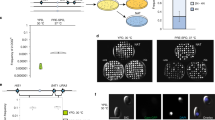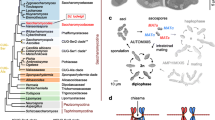Summary
Sporulation was followed in diploid pedigrees of the fission yeast Schizosacharomyces pombe of the genotype h 90 //h −U. From the pattern of dividing cells and asci over 6–8 cell cyles information was gathered on the underlying laws regulating mating-type switching in this year. The results are discussed in relation to the introduction and transmission of double-strand breaks at the smt signal dose to the mat1 cassette. Such cuts have previously been reported as being a prerequisite for mating-type switching. The general criteria appear as follows. Each cell giving rise to a switch carries a cut at smt. A newly switched cassette is not associated with a cut. The sister cell to a newly switched cell retains bot the original cassette and the double-strand cut. Most of the time a “virgin” cell without the cut divides unequally so that one and only one of the daugthers obtains a cut. The consequence of these criteria is that long series of switch after switch in the same direction (“recurrent swtiching”) were observed in the pedigrees.
Similar content being viewed by others
References
Beach DH (1983) Nature 305:682–687
Beach DH, Mar AJS (1984) EMBO J 3:603–610
Egel R (1984a) Curr Genet 8:199–203
Egel R (1984b) Curr Genet 8:205–210
Egel R, Egel-Mitani M (1974), Exp Cell Res 88:127–134
Egel R, Gutz H (1981) Curr Genet 3:5–12
Egel R, Beach DH, Mar AJS (1984) Proc Natl Acad Sci USA 81:3481–3485
Klar AJS (1987) Nature 326:466–470
Klar AJS, Miglo LM (1986) Cell 46:725–731
Leupold U (1950) C R Lab Carlsberg Ser Physiol 24:381–480
Miyata H, Miyata M (1981) J Gen Appl Microbiol 27:365–371
Schiønning H (1895) Medd Carlsberg Lab 4:77–84
Author information
Authors and Affiliations
Rights and permissions
About this article
Cite this article
Egel, R., Eie, B. Cell lineage asymmetry in Schizosaccharomyces pombe: unilateral transmission of a high-frequency state for mating-type switching in diploid pedigrees. Curr Genet 12, 429–433 (1987). https://doi.org/10.1007/BF00434820
Received:
Issue Date:
DOI: https://doi.org/10.1007/BF00434820




